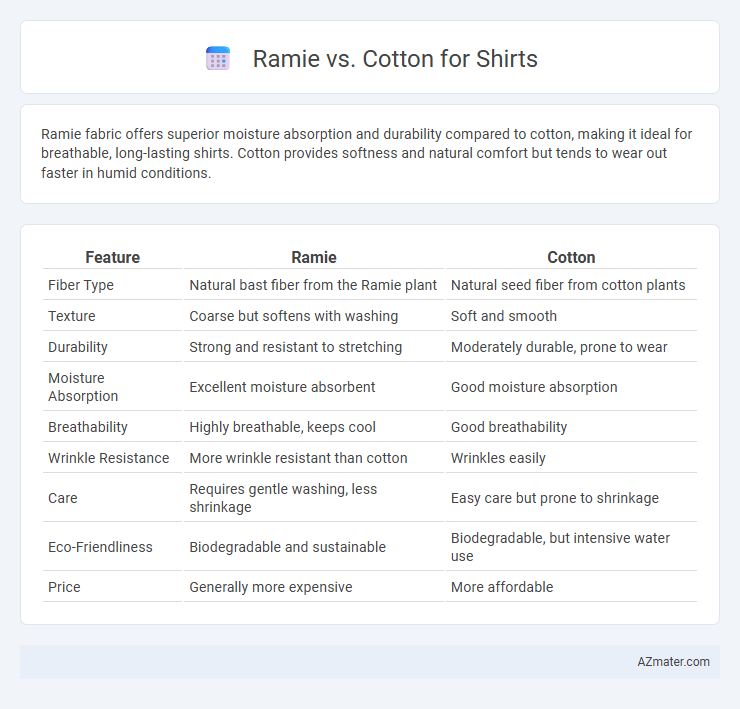Ramie fabric offers superior moisture absorption and durability compared to cotton, making it ideal for breathable, long-lasting shirts. Cotton provides softness and natural comfort but tends to wear out faster in humid conditions.
Table of Comparison
| Feature | Ramie | Cotton |
|---|---|---|
| Fiber Type | Natural bast fiber from the Ramie plant | Natural seed fiber from cotton plants |
| Texture | Coarse but softens with washing | Soft and smooth |
| Durability | Strong and resistant to stretching | Moderately durable, prone to wear |
| Moisture Absorption | Excellent moisture absorbent | Good moisture absorption |
| Breathability | Highly breathable, keeps cool | Good breathability |
| Wrinkle Resistance | More wrinkle resistant than cotton | Wrinkles easily |
| Care | Requires gentle washing, less shrinkage | Easy care but prone to shrinkage |
| Eco-Friendliness | Biodegradable and sustainable | Biodegradable, but intensive water use |
| Price | Generally more expensive | More affordable |
Introduction to Ramie and Cotton
Ramie is a natural fiber derived from the stalks of the Chinese nettle plant, known for its exceptional strength, lustrous appearance, and resistance to wrinkles and mildew. Cotton, a widely used natural fiber from the cotton plant, is prized for its softness, breathability, and moisture absorption, making it a staple in shirt production worldwide. While both fibers offer unique qualities, ramie provides superior durability and shine, whereas cotton excels in comfort and versatility for everyday wear.
Fiber Origins and Production Processes
Ramie, derived from the stalks of the Boehmeria nivea plant, is one of the oldest fiber crops, primarily produced in China and the Philippines through a labor-intensive process involving harvesting, decortication, and degumming to extract strong, lustrous fibers. Cotton fibers come from the seed hairs of the Gossypium plant, widely cultivated in the United States, India, and China, where mechanical harvesting and ginning separate the fibers from seeds, making cotton production more mechanized and scalable. The natural strength and mildew resistance of ramie fibers contrast with cotton's softness and breathability, influencing their respective uses in shirt manufacturing.
Texture and Feel: Comparing Comfort
Ramie fabric offers a crisp, slightly coarse texture that softens with washing, providing a breathable and moisture-wicking feel ideal for hot climates. Cotton, known for its smooth and soft texture, delivers superior comfort with natural stretch and excellent breathability, making it a popular choice for everyday wear. While ramie excels in durability and a distinctive sheen, cotton remains preferred for its unmatched softness and gentle feel against the skin.
Durability and Longevity
Ramie fibers exhibit excellent durability, often surpassing cotton in tensile strength and resistance to wear, making shirts crafted from ramie more resistant to tearing and abrasion. Cotton shirts provide comfort and breathability but tend to show signs of wear faster due to fiber weakness from repeated laundering and exposure to sunlight. Choosing ramie results in longer-lasting shirts that maintain structural integrity over time, ideal for garments requiring extended durability.
Breathability and Moisture Absorption
Ramie fabric offers superior breathability compared to cotton, allowing air to circulate more freely and keeping the wearer cooler in hot weather. Its natural fibers have excellent moisture absorption capabilities, wicking sweat away from the body to enhance comfort during physical activity. Cotton also provides good breathability and moisture absorption but tends to retain moisture longer, making ramie a better choice for shirts in humid or warm climates.
Eco-Friendliness and Sustainability
Ramie shirts offer significant eco-friendliness due to their production from the natural fiber of the Chinese nettle plant, which requires minimal pesticides and water compared to cotton cultivation. Cotton, while widely used, often demands intensive water usage and chemical treatments, making its environmental impact heavier. Choosing ramie supports sustainable fashion by promoting biodegradable textiles with a smaller ecological footprint and reduced soil depletion.
Color Retention and Dyeing Qualities
Ramie fabric exhibits superior dye absorption and vibrant color retention due to its high cellulose content and smooth fiber structure, making it ideal for shirts requiring bright and long-lasting hues. Cotton, while versatile and widely used, tends to fade faster over time because its fiber absorbs dye less uniformly and is more prone to wear during washing. The stronger bond between dye molecules and Ramie fibers results in enhanced colorfastness, contributing to shirts with more enduring and vivid colors compared to cotton.
Maintenance and Care Requirements
Ramie shirts require gentle washing with mild detergents to maintain their natural luster and prevent fiber brittleness, and they should be air-dried to avoid heat damage. Cotton garments can endure higher washing temperatures and frequent laundering, offering easier stain removal and better durability during routine maintenance. Both fabrics benefit from ironing, but ramie demands lower heat settings due to its delicate fibers compared to the more heat-resistant cotton.
Price and Availability
Ramie shirts typically cost more than cotton due to the labor-intensive harvesting process and limited large-scale production. Cotton is widely available globally, making cotton shirts more affordable and easier to find in various styles and qualities. The price difference often reflects cotton's mass production efficiency versus ramie's niche market exclusivity.
Best Uses: Choosing the Right Fabric for Your Shirt
Ramie fabric excels in moisture-wicking and durability, making it ideal for summer shirts and activewear due to its breathable nature and resistance to wrinkles. Cotton offers exceptional softness and comfort, perfect for everyday casual and dress shirts that require a smooth, breathable fabric. For best results, choose ramie for crisp, long-lasting shirts in hot climates, while cotton suits versatile, soft garments with easy care.

Infographic: Ramie vs Cotton for Shirt
 azmater.com
azmater.com